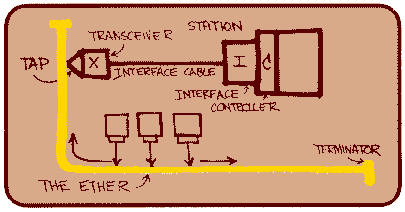|
Samuel B. Morse’s regenerative repeater invention for amplifying weak telegraphic signals has recently been resurrected and transistorized. Morse’s electrical relay permits amplification of weak binary telegraphic signals above a fixed threshold. Experiments by various organizations (primarily the Bell Telephone Laboratories) have shown that digital data rates on the order of 1.5 million bits per second can be transmitted over ordinary telephone line at repeater spacings on the order of 6,000 feet for #22 gage pulp paper insulated copper pairs. At present, more than 20 tandemly connected amplifiers have been used in the Bell System T-l PCM multiplexing system without retiming synchronization problems.
There appears to be no fundamental reason why either lines of lower loss, with corresponding further repeater spacing, or more powerful resynchronization methods cannot be used to extend link distances to in excess of 200 miles. Such distances would be desired for a possible national distributed network. Power to energize the miniature transistor amplifier is transmitted over the copper circuit itself. – Paul Baran, On Distributed Communications, Volume I, 1964. |
Ethernet provides the local area networking technology that has spread the Internet throughout our offices and cities. Technically, it’s a physical transmission standard for digital radio frequency communication over copper wire networks. Ethernet networking is the most common physical networking standard. It supports TCP/IP networking seamlessly, and provides an inexpensive, simple, high bandwidth method for interconnection of local computers. Ethernet solved the all important “last mile” problem, and remains the standard method of connecting personal computers to the Internet at the office, and at home over high bandwidth connections.
In the late 1960’s, engineering developments were rapidly improving integrated circuit development and computer display monitors. In order to complete the technological triangle, Xerox PARC invented Ethernet networking, providing a fast, simple, predictable local area networking standard. Robert Metcalfe and David Boggs led the development.
Who invented Ethernet? Robert Metcalfe got the idea for the Ethernet protocol when he read a 1970 computer conference paper by Norman Abramson of the University of Hawaii about the packet radio system called ALOHAnet linking the Hawaiian Islands. Each node in ALOHAnet sent out its messages in streams of separate packets of information. If it didn’t get an acknowledgment back for some packets because two radios were broadcasting at the same time, then the missing packets were considered “lost in the ether”.
When a packet was lost in the ether, the node would rebroadcast them after waiting a random interval of time. Because of this randomness, problems with collisions were quickly resolved except under the highest traffic loads. On average, the network rarely had to retry more than once or twice to get all of the packet to the destination, which was more efficient than trying to implement a complex coordination system to prevent collisions in the first place.
Abramson’s design showed that, while it worked well, ALOHAnet reached its maximum traffic load at only 17% of its potential maximum efficiency, because of a great increase in collisions at higher loads. Metcalfe chose this problem for his computer science thesis, and, as a graduate student at Harvard, showed that you could use mathematical queuing theory to achieve 90% efficiency of the potential traffic capacity without being locked up by the packet collisions.
Below is a drawing that Robert Metcalfe made to present Ethernet to the National Computer Conference in June 1976.

Charles Spurgeon’s Ethernet Site
Ethernet is now by far the most common local area network. Metcalfe went on to found 3Com in 1981, a maker of Ethernet network cards and other communications products, and became one of the largest telecommunications companies in the world.
The first version of the Ethernet standard had a bandwidth of 2.94 Mbps, or about 300,000 characters a second. The current version is standardized as IEEE 802.3, and provides a bandwidth of 10 Mbps or about 1,000,000 characters a second, over normal twisted pair telephone wires, and is the most commonly deployed local area networking standard. Recent advances in the technology have resulted in development of 100 Mbps and 1 Gbps Ethernet standards, which are increasingly being deployed for high bandwidth environments.
Every Ethernet network interface has a unique MAC address. RFC 826 describes how to obtain an IP address from an Ethernet MAC address.
Bob Metcalfe wrote Request For Comments 602, The Stockings Were Hung by the Chimney with Care, in December, 1973, including descriptions of incidents of hacking only four years after the birth of the ARPANET.
Resources. The following sites provide additional Information about Ethernet: